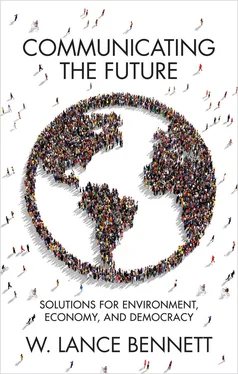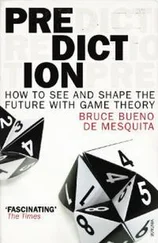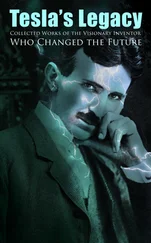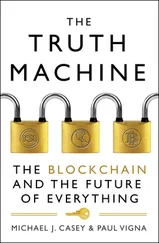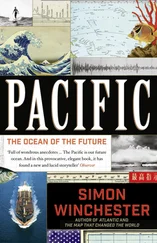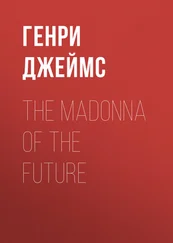The path to more effective political action involves communicating about economics, politics, and environment, together, in ways that offer more appealing images of change than commonly associated with proposals for carbon taxes or radical sacrifices in how we consume and live. Various personal adjustments will surely come at some point down the road, but this is the wrong end of the problem to emphasize now. Many people are already living at the margins, both north and south, and there is little to gain from making the road ahead seem even worse. Broad public support for positive change is needed to pressurize political parties in democracies for better policies that package equity and environment together.
Finding ways to develop and spread ideas that might actually make a difference is challenging for many reasons, including: resistance from short sighted business interests; caution from parties and governments captured by those interests; and disinformation from growing rightwing movements that have mobilized large publics against many progressive policies, including climate change. Rightwing organizations in Europe and the US even found a German teenager named Naomi Seibt to play the role of the “anti-Greta” on YouTube, in publications, and at conferences in the US and Europe.
It is easy to blame the lack of decisive progress on the environmental crisis on business interests, timid politicians, the noise from popular movements, and leaders on the radical right. While those factors loom large, it is also time to put the spotlight on the millions of concerned citizens, environmental organizations, and aligned activists who have done an excellent job sounding alarms and winning small victories but continue to lose the larger fight for a more livable future. Those calling for change are majorities in many nations. It is time for us all to change our thinking about the role of communication in building stronger political action networks that can develop and spread clearer ideas about more livable societies. And we need to understand how transformative ideas acquire the clarity and commitment to fuel movements that resonate with publics and politicians.
At the core of the problem is how we routinely communicate about complex problems like climate change and the many other symptoms of environmental collapse that intersect with critical life spheres such as economics and politics. The language and logics that we encounter in news accounts, from experts and politicians, and in everyday conversations, tend to chop big problems up into small solutions that don’t add up. And even those approaches often employ backwards thinking that focuses on treating symptoms rather than underlying causes. It turns out that many communication scholars and practitioners also approach complex problems with relatively narrow communication models based on message framing, audience targeting, or trying to set political and media agendas. Even when these strategies are successful, the resulting proposals mainly address environmental symptoms such as reducing carbon emissions, rather than focusing on underlying economic causes of continuing rising economic demand for fossil fuels. Better communication entails recognizing that complex problems typically have intersecting causes: for example, environmental problems are fundamentally economic and political in nature. The challenge is to develop simple models that enable better communication about this.
Rather than continue to reproduce communication that does not work well, we now have the capacity to understand and shape how transformational ideas flow in societies. We can explain a good deal about dense flows of content that involve rich mixes of images, memes, political slogans, scientific evidence, narratives, and the media influencers who bridge, filter, or block idea flows across different networks. We can use these understandings to help civil-society organizations, movements, concerned citizens, and politicians better coordinate the production, packaging, and networking of game-changing ideas. Communication scholars can find new ways to assemble old concepts, and add a few new ones, with the aim of better understanding how networked communication processes engage and organize people in complex media ecologies.
In short, the challenge for positive political change is not so much what to do about the radical right; in most democracies they are greatly outnumbered by citizens concerned about the environment and economic failures. Even business resistance is beginning to soften in some sectors, and investors are finally figuring out that oil stocks may not have such a bright future. The challenge ahead is for environmental, new economy, and political reform organizations (and their funders!) to develop more coherent ideas that offer positive visions for a more sustainable future. Unified movements spreading those ideas can engage voters and help leverage political parties to take action. If these things happen, then attractive packages such as The Green New Deal will be filled with truly transformative ideas.
Communicating the Future is not a book that invents new proposals for building a better world. There are plenty of good ideas about economic and democratic reform already in circulation, many dating back more than half a century. If simply writing about good ideas caused social and political change, we would not be in the current mess. The main focus of the book is on what has been missing: a simple model that citizens, organizations, and communication scholars can use to think and act differently about a set of problems that current approaches are failing to solve. This model of how ideas flow in society shows how think tanks, activist organizations, funders, and engaged publics can: (a) develop communication processes that (b) better enable diverse groups in different societies (c) to build stronger networks with common agendas, (d) that gain support in elections and policy processes, and (e) receive uptake from political parties and governments. Until these things happen, the reactionary right will continue to outperform the radical left in elections, and parties on the center left (e.g. European Social Democrats, US Democrats) and the center right (e.g. Christian Democrats) will continue to drift.
To aid the reader’s thinking about building more effective models of political communication, the book shows how other transformative ideas have traveled in society and into politics. For example, Chapter 3traces the origins and spread of the core principles of the currently dystopian economic system of global, deregulated, and ecologically predatory capitalism. The current economic operating systems in most nations will continue to defeat efforts to treat the multiplying environmental symptoms until coalitions of different stakeholders develop and implement more attractive alternatives. The aim is to show how those already concerned about the future can develop ideas about more equitable and ecologically sound societies and organize more effective politics to guide the transitions.
A place to start is with assessing the ever-expanding lists of specific issues that do not add up to a compelling vision for change: save the polar bears, stop oil drilling in the Arctic, protect the old growth forests, quit mining coal, stop burning the Amazon, tax carbon, build more renewable energy, and on and on. As our failing economic and political practices create more and more problems, it is easy to understand why so much energy is focused on trying to deal with them all. However, as noted earlier, the politics attached to all of that issue-specific communication generally ends up fighting the symptoms of an economic system that spews more new problems than any amount of issue-by-issue action can fix. Moreover, all of those worthy causes compete against each other for attention, empathy and action.
Читать дальше
